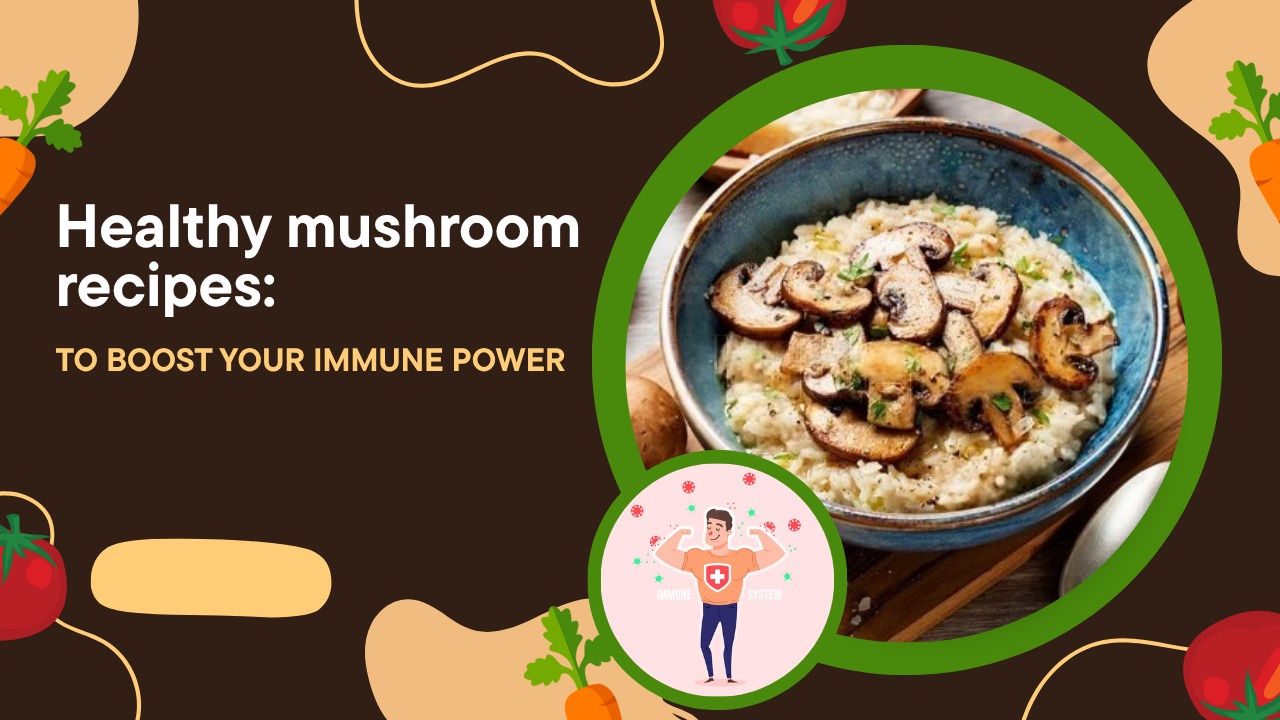Healthy mushroom recipes are a fantastic way to enhance your meals with rich flavor and powerful nutrition. Mushrooms are low in calories, fat-free, and loaded with antioxidants, fiber, and essential vitamins like B-complex and vitamin D. Whether you’re vegetarian, vegan, or just aiming for a more nutrient-dense diet, mushrooms can elevate your culinary experience without added calories.
With a wide variety to choose from—like white button, cremini, portobello, shiitake, and maitake—there’s a mushroom for every dish and preference. These fungi adapt well to stir-fries, soups, salads, pastas, and even grilled main dishes, making them ideal for creative, healthy mushroom recipes that fit any meal plan.
What truly sets mushrooms apart is their unique combination of taste and health benefits. They support immune health, may help manage blood sugar levels, and are known for their anti-inflammatory properties. Incorporating healthy mushroom recipes into your routine is an easy and delicious step toward better health.
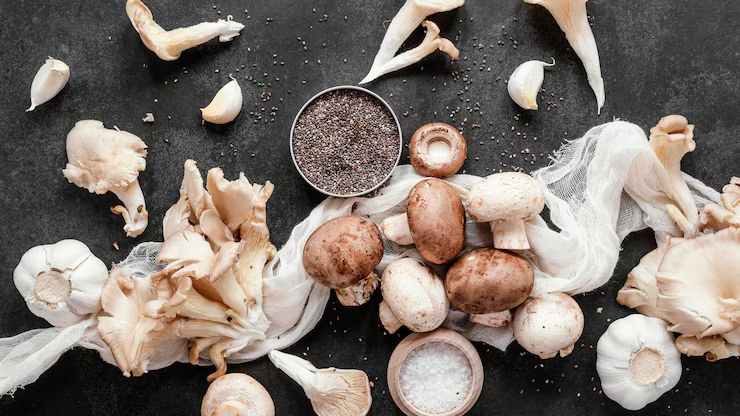
What Makes Mushrooms Healthy ?
Mushrooms are packed with essential nutrients, including vitamins, minerals, fiber, and antioxidants, which contribute to various health benefits. Notably, mushrooms are a great source of B-vitamins, such as B2 (riboflavin) and B3 (niacin), which are crucial for energy production and maintaining healthy skin, hair, and eyes. They also contain immune-boosting compounds like beta-glucans and antioxidants like selenium, which help to fight free radicals in the body.
Additionally, mushrooms are low in calories and fat, making them ideal for those who want to maintain a healthy weight. Their high fiber content aids in digestion and promotes gut health. Furthermore, some mushrooms, such as shiitake and maitake, are known for their potential to support cardiovascular health and even fight inflammation.
Why You Should Include Mushrooms in Your Diet
Healthy mushroom recipes aren’t just delicious—they also deliver a wide range of health benefits. Mushrooms are rich in essential nutrients like B vitamins, selenium, potassium, and antioxidants, all of which support immune health, fight inflammation, and promote better energy levels throughout the day.
Incorporating mushrooms into your diet regularly can aid digestion due to their fiber content and help with weight management, as they are low in calories and fat while providing a satisfying, meaty texture. They’re also known to support heart health by helping to regulate cholesterol levels and blood pressure, thanks to their bioactive compounds.
By making mushrooms a regular part of your meals through healthy mushroom recipes, you’re not only adding variety and flavor but also promoting long-term wellness. Whether you roast them, blend them into soups, or sauté them with greens, mushrooms are a functional superfood that can make a big impact on your overall health.
Some of the top reasons to include more mushrooms in your meals include:
Boosts Immune Health: Mushrooms contain beta-glucans, which enhance the immune system’s ability to fight infections.
Rich in Antioxidants: Mushrooms are full of antioxidants, such as selenium and ergothioneine, that protect against cell damage caused by free radicals.
Supports Weight Loss: Low in calories and high in fiber, mushrooms can help with weight management and support healthy digestion.
Improves Heart Health: Certain types of mushrooms contain compounds that may reduce cholesterol and support cardiovascular health.
When to Incorporate Mushrooms in Your Meals
Healthy mushroom recipes are perfect for every season, thanks to the year-round availability and versatility of mushrooms. While they’re especially flavorful and abundant during cooler months, mushrooms can be used in comforting fall stews, winter soups, spring salads, and even summer grilling recipes.
In autumn and winter, hearty mushrooms like portobello, cremini, and shiitake are ideal for warming dishes such as casseroles, roasted veggie bowls, and savory broths. Their rich, earthy flavor adds depth and nourishment to any meal, making them a favorite for cold-weather cooking.
During the warmer months, mushrooms shine in lighter dishes like salads, wraps, and grilled skewers. Fresh varieties are widely available in grocery stores year-round, making it easy to incorporate them into your cooking no matter the season. Whether you’re crafting a hot meal or a refreshing side, healthy mushroom recipes offer endless possibilities to enjoy their taste and health benefits all year long.
Healthy mushroom recipes are perfect for:
Weeknight dinners: Add them to pasta dishes, stir-fries, or soups for a quick, satisfying meal.
Weekend brunches: Mushrooms are a great addition to omelets, frittatas, and savory pancakes.
Meal prep: Mushrooms can be used in meal prep for lunches and dinners throughout the week, such as in grain bowls, wraps, or salads.
How to Make Healthy Mushroom Recipes
Healthy mushroom recipes are easy to create with the right ingredients and cooking methods. Start by selecting fresh mushrooms like cremini, portobello, shiitake, or maitake, each offering unique textures and flavors. Clean them gently with a damp cloth and trim the stems if needed—avoiding soaking, as mushrooms absorb water easily.
Choose healthy cooking techniques such as grilling, roasting, or sautéing with heart-healthy oils like olive or avocado oil. Avoid heavy creams and butters by using Greek yogurt, low-sodium broth, or plant-based milk to create lighter sauces. Pair mushrooms with lean proteins, whole grains, or fresh vegetables to make balanced meals.
Incorporate mushrooms into soups, salads, stir-fries, and even breakfast or smoothies for variety. With their rich umami flavor and nutritional profile, healthy mushroom recipes can easily become a staple in your diet. They’re simple, satisfying, and perfect for anyone looking to eat well without sacrificing flavor.
Creating healthy mushroom recipes is straightforward and can be done with minimal effort. Here are the general steps for preparing mushroom-based dishes:
Choose your mushrooms: Decide on the type of mushroom that fits the recipe—button mushrooms, shiitake, portobello, or others.
Clean the mushrooms: Gently wipe them with a damp cloth or paper towel. Avoid rinsing them under water as mushrooms are like sponges and can absorb water, affecting their texture.
Cook them properly: Depending on the recipe, you can sauté, grill, roast, or use mushrooms in soups. Sautéing mushrooms in a small amount of olive oil or butter enhances their natural flavors.
Season well: Mushrooms pair beautifully with garlic, thyme, rosemary, soy sauce, and balsamic vinegar. Feel free to experiment with different herbs and spices to create the perfect flavor profile.
Incorporate them into the dish: Once cooked, mushrooms can be added to a variety of dishes, including pasta, salads, grain bowls, and sandwiches.
Tips for Healthy Mushroom Recipes
Choose a Variety of Mushrooms
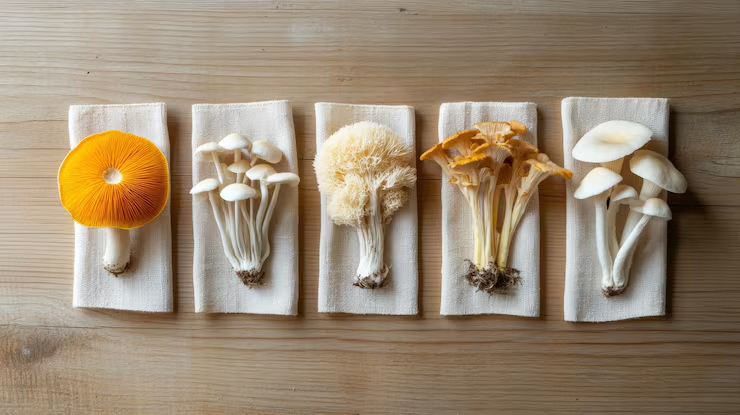
Healthy mushroom recipes become more exciting and nutritious when you use a variety of mushrooms. Each type brings its own flavor, texture, and health benefits to the table, making your dishes more diverse and enjoyable. Incorporating multiple mushroom types not only boosts the nutritional profile but also enhances the depth of your recipe.
White button mushrooms are mild and great for everyday cooking, while cremini mushrooms add a richer flavor. Portobello mushrooms are perfect as meat substitutes due to their size and texture. Shiitake mushrooms offer an earthy, smoky taste and are known for their immune-supporting compounds. Maitake mushrooms, also called “hen of the woods,” are loaded with antioxidants and have a delicate, frilly texture.
By mixing different varieties, your healthy mushroom recipes will deliver a full spectrum of nutrients and tastes. It’s a simple way to upgrade your meals while enjoying the unique benefits each mushroom has to offer.
Benefit: Different types of mushrooms offer unique textures and flavors. Combining varieties in your recipes adds depth and complexity.
Ingredients: White button, cremini, shiitake, portobello.
Tip: Mix button mushrooms with shiitake or maitake mushrooms for a heartier dish.
Sauté With Healthy Fats
Healthy mushroom recipes can be made even more nutritious by choosing the right cooking fats. Sautéing mushrooms enhances their natural flavor, and using healthy fats like olive oil, avocado oil, or a small amount of ghee can add extra health benefits without unnecessary calories or processed ingredients.
Olive oil is a popular choice for its heart-healthy monounsaturated fats and anti-inflammatory properties. It complements mushrooms beautifully, bringing out their earthy flavor while adding a light richness. Avocado oil, with its high smoke point, is excellent for higher-heat cooking and adds a subtle buttery taste to your mushroom dishes.
Avoid heavy butter or margarine, which can add unhealthy saturated or trans fats. Instead, use small amounts of healthy oils to maintain the clean, nutrient-rich profile of your healthy mushroom recipes. This simple adjustment not only supports better health but also elevates the taste and quality of your meals effortlessly.
Benefit: Sautéing mushrooms with olive oil or avocado oil enhances flavor and increases absorption of fat-soluble vitamins like vitamin D.
Ingredients: 1 tablespoon olive oil, garlic, and a pinch of salt.
Tip: Avoid excessive butter to keep your dish heart-healthy.
Add Mushrooms to Breakfast Dishes
Healthy mushroom recipes aren’t just for lunch or dinner—they’re perfect for breakfast too. Adding mushrooms to your morning meals can boost fiber, protein, and antioxidants early in the day, helping you feel fuller longer and stay energized.
You can sauté mushrooms and fold them into omelets or scrambled eggs, creating a protein-packed, savory start to your day. They also work well in breakfast burritos, frittatas, or on top of whole grain toast with avocado. Their meaty texture and umami flavor make them a satisfying addition without the need for processed meats.
Including mushrooms in your breakfast routine is an easy way to add variety and nutrients to your mornings. With so many delicious ways to prepare them, healthy mushroom recipes for breakfast can help you stay on track with your wellness goals while keeping your meals flavorful, filling, and fun. Start your day right with the power of mushrooms.
Benefit: Starting your day with a savory breakfast rich in nutrients can help keep you full and energized.
Ingredients: Mushrooms, eggs, spinach, and whole-grain toast.
Tip: Add mushrooms to scrambled eggs, omelets, or a veggie-loaded breakfast burrito.
Pair Mushrooms with Protein
Healthy mushroom recipes can become even more satisfying and balanced when paired with a good source of protein. Mushrooms alone are low in calories and rich in nutrients, but when combined with protein, they create a well-rounded meal that supports muscle health, satiety, and energy levels.
Try pairing mushrooms with lean proteins like grilled chicken, turkey, or tofu in stir-fries, soups, or salads. For plant-based options, mushrooms go well with lentils, beans, or quinoa, making the dish both hearty and nutritious. The rich umami flavor of mushrooms enhances the taste of almost any protein source without overpowering it.
This combination not only boosts the nutritional value of your meal but also helps stabilize blood sugar and keeps you full for longer. Whether you’re following a meat-based or plant-based diet, adding protein to your healthy mushroom recipes ensures your meals are both delicious and nutritionally complete.
Benefit: Mushrooms complement plant-based or animal proteins, making your meal more balanced.
Ingredients: Mushrooms, tofu or chicken, quinoa, and broccoli.
Tip: Try adding mushrooms to stir-fries or grilled meats for a nutritious, protein-packed meal.
Use Mushrooms in Soups and Stews
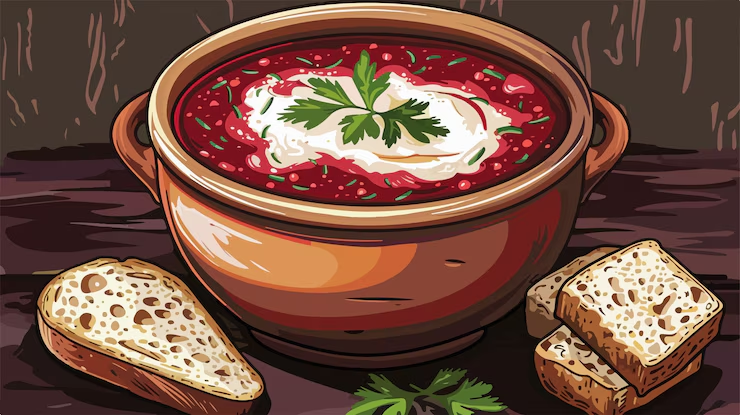
Healthy mushroom recipes shine in comforting soups and hearty stews. Mushrooms add depth, umami flavor, and a satisfying texture that makes them a perfect ingredient in both vegetarian and meat-based broths. They absorb surrounding flavors beautifully while enriching dishes with their earthy taste.
From classic mushroom barley soup to creamy blended mushroom bisques, the options are endless. You can also add chopped mushrooms to lentil stews, vegetable soups, or chicken-based broths to create a more robust and nutrient-dense meal. Shiitake, cremini, and portobello mushrooms are especially great for soups due to their rich flavors and meaty consistency.
Using mushrooms in soups and stews boosts fiber and adds antioxidants without increasing fat or calories, making your meals both wholesome and filling. Whether as the star ingredient or a flavorful addition, incorporating mushrooms into your healthy mushroom recipes ensures your dishes are warming, nourishing, and full of natural goodness.
Benefit: Mushrooms absorb the rich flavors of soups and stews while adding a meaty texture, making them great for vegetarian or vegan dishes.
Ingredients: Mushrooms, vegetable broth, onions, carrots, and thyme.
Tip: Combine with legumes like lentils or chickpeas for extra fiber.
Opt for Grilled or Roasted Mushrooms
Healthy mushroom recipes become even more flavorful and nutrient-rich when you opt for grilling or roasting instead of frying. These cooking methods enhance the natural umami taste of mushrooms while preserving their nutritional value and minimizing added fats.
Grilling mushrooms brings out a smoky, caramelized flavor that pairs well with lean meats, whole grains, or fresh salads. Simply toss mushrooms in a little olive oil, garlic, and herbs before placing them on the grill for a delicious side or main dish. Roasting, on the other hand, intensifies their earthy flavor and gives them a tender yet slightly crisp texture—perfect for adding to bowls, pasta, or wraps.
Both methods are quick, easy, and ideal for meal prep. By grilling or roasting instead of frying, your healthy mushroom recipes stay low in calories while still being satisfying and packed with flavor. It’s a smart and tasty way to incorporate more mushrooms into your diet.
Benefit: Roasting or grilling mushrooms enhances their natural umami flavor without adding excessive fats.
Ingredients: Mushrooms, olive oil, balsamic vinegar, garlic.
Tip: Serve roasted mushrooms as a side dish or top them on pizza for a gourmet touch.
Incorporate Mushrooms in Smoothies
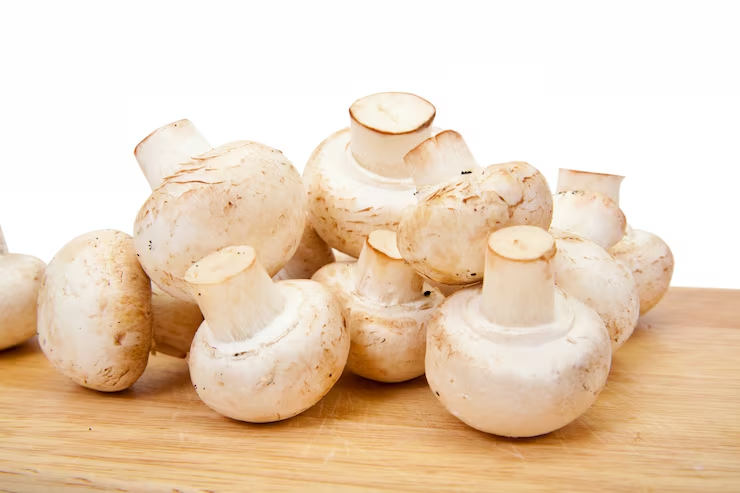
Healthy mushroom recipes can go beyond savory dishes—yes, even into your smoothies! While it may sound unusual, adding certain types of mushrooms to smoothies is a growing trend, especially in wellness and plant-based communities. Medicinal mushrooms like reishi, lion’s mane, and chaga are commonly used for their adaptogenic and immune-boosting properties.
These mushrooms are typically dried and ground into powder, making them easy to blend into your favorite smoothie without altering the flavor too much. They pair well with ingredients like bananas, berries, cocoa, and plant-based milk, giving your smoothie an earthy richness while enhancing its health benefits.
Incorporating mushrooms into your morning or post-workout smoothies is a creative way to expand your use of healthy mushroom recipes. It allows you to enjoy the many nutritional benefits mushrooms offer—such as antioxidants, beta-glucans, and brain-supporting compounds—in a simple, on-the-go form. It’s functional nutrition made delicious and easy.
Benefit: Adding a handful of mushrooms to a smoothie provides a unique earthy flavor while boosting its nutritional value.
Ingredients: Mushrooms, spinach, almond milk, and banana.
Tip: Blend them with sweet fruits like berries and apples to balance out their taste.
Make Mushroom Sauces
Healthy mushroom recipes can be taken to the next level with rich, savory mushroom sauces that add flavor without excess calories. Whether you’re serving them over whole grains, vegetables, or lean proteins, mushroom sauces are a smart, delicious way to enhance your meals.
Using a base of sautéed mushrooms with garlic, onions, and herbs, you can create sauces with low-fat milk, Greek yogurt, or vegetable broth for a creamy consistency. Skip the heavy cream and butter—these lighter alternatives maintain creaminess while supporting your health goals. Add a splash of balsamic vinegar or lemon juice for brightness and depth.
Homemade mushroom sauces are not only versatile but also quick to prepare, making them ideal for busy weeknights. By incorporating them into your healthy mushroom recipes, you boost flavor and texture without unnecessary fat or sodium. It’s a simple upgrade that brings gourmet taste and wholesome ingredients together in perfect balance.
Benefit: Mushroom sauces are a flavorful, healthy alternative to creamy sauces.
Ingredients: Mushrooms, garlic, vegetable stock, and herbs.
Tip: Drizzle over pasta, rice, or grilled meats for an umami-packed topping.
Conclusion
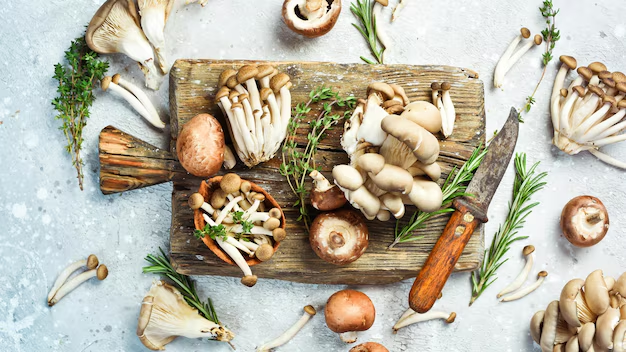
Healthy mushroom recipes are an easy and flavorful way to boost your nutrition. With their wide range of health benefits, including immune support, antioxidants, and heart health, mushrooms should definitely be a staple in your diet. Whether you’re looking to reduce calories, add more fiber, or simply enjoy delicious meals, mushrooms can fit seamlessly into every dish.
By following the tips and incorporating mushrooms into your meals, you can enjoy tasty and nutritious dishes that nourish your body and please your palate. Don’t hesitate to experiment with different types of mushrooms, flavors, and cooking methods to find the best healthy mushroom recipes for you. In conclusion, mushrooms are not just a culinary delight; they are a powerhouse of nutrition that can support your health in many ways.
FAQs
Q1. Are mushrooms a good source of protein ?
Yes, mushrooms provide a small amount of protein. While they are not as high in protein as animal products or legumes, they can contribute to your daily intake.
Q2. Can I eat mushrooms raw ?
Yes, mushrooms can be eaten raw, but cooking them enhances their flavor and digestibility.
Q3. Are mushrooms good for weight loss ?
Yes, mushrooms are low in calories and high in fiber, making them ideal for weight management. They help you feel full longer without adding excess calories.
Q4. What is the best way to cook mushrooms ?
Sautéing or roasting are popular and healthy methods to cook mushrooms. These methods help bring out their umami flavor while keeping them low in fat.
Q5. Can mushrooms help boost my immune system ?
Yes, mushrooms contain beta-glucans, which are known to enhance immune function and help fight off infections.

